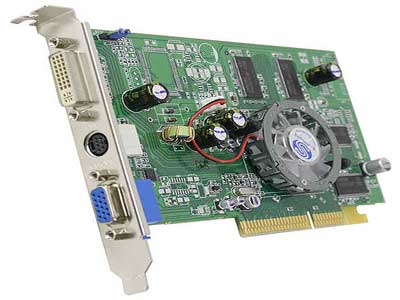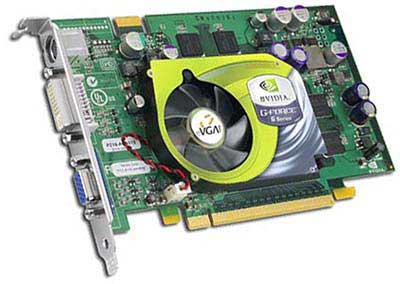Buyer's Guide - Mid-Range, October 2004
by Jarred Walton on October 21, 2004 11:00 AM EST- Posted in
- Guides
Graphics Recommendations
The only typical applications that actually require a decent graphics card are games, but depending on how you plan to use the system, adding a little more power to the graphics subsystem may not be a bad idea. We listed an integrated graphics motherboard as an option for a base Intel system, and that will save you a little money. For the AGP models, a basic Radeon or GeForce will get you by. One of the advantages of purchasing an add-in card is that even the basic models support two displays. This is definitely an advantage for software development and content creation work, where having dozens of windows open at a time is par for the course.Those who are interested in more serious work, like 3D modeling and rendering, might want to look into professional 3D graphics cards, although moderate consumer graphics cards will be sufficient for less serious work. Those looking for an all-around system will also want more than just a basic graphics card. With that said, let's get on to the recommendations.

AGP Recommendation: Sapphire Radeon 9600 Pro 128MB
Price: $108 Shipped (OEM)
At just over $100, the 9600 Pro offers tremendous value. Casual gamers will have more than enough performance for most games, while those interested in content creation or software development get the proven reliability and performance of ATI's drivers. TV Out is also included, for those who might be looking for a Home Theater PC. While it might seem like overkill for anyone who doesn't use any form of 3D graphics, it is hard to recommend anything less than a DirectX 9.0 capable graphics card for any system costing over $1000. Remember that Windows Longhorn - assuming it ships anytime soon - is going to require DX9 support as the bare minimum in order to run. The one option that isn't available for this price is dual DVI output, so those looking at running dual LCD displays might want to find a model that has two DVI ports. While the performance is lower, HIS makes a dual DVI 9600 card that might interest some of you. Downgrading to a stock 9600 or even a 9600SE is also an option if you are sure you don't need the added performance of the 9600 Pro.

Basic PCIe Recommendation: Sapphire Radeon X300 128MB
Price: $85 Shipped (OEM)
PCI Express graphics cards tend to carry a slight price premium, and the X300 is actually comparable to the 9600. The X600 Pro matches the clock speeds of the 9600 Pro, but it costs a little more. For basic computing tasks other than gaming, they will both perform acceptably, so here we go with the slightly cheaper X300. Unfortunately - or fortunately if you're looking for an excuse to upgrade - those looking for dual DVI ports will need to buy a 6600GT card for the time being; specifically, the XFX is one card that includes that option. There are no other PCI Express graphics cards with two DVI ports other than the ultra-expensive X800 XT and Quadro FX1300, which really aren't an option for this price range.

PCIe Alternative: eVGA 6600GT 128MB
Price: $207 Shipped (Retail)
Here, PCI Express has a slight advantage in the price/performance category. The 6600GT includes 8 pixel pipelines, and with a core clock of 500 MHz, it outperforms any AGP card in the same price bracket. ATI's X700 Pro is also available at about the same price and it is similar in features, but comes with 256 MB of GDDR3. The X700XT with 128 MB of RAM and faster clock speeds is also due to show up in retail any time now, but we have not been able to find it there yet. This is really a gaming option, but we would feel remiss if we didn't at least mention it, as the 6600GT is one of the best price/performance graphics cards currently available.
For AGP systems that will be used for moderate amounts of gaming, the only comparable card right now is the 9800 Pro. It's a bit slower in most games and lacks support for SM3.0 but it performs acceptably. The GeForce 6800 is also an option that is slightly faster than the 6600GT and costs a bit more.










54 Comments
View All Comments
Confusednewbie1552 - Saturday, October 23, 2004 - link
Great, I've had my computer for 2 months and have been only using it for only a month and already it becomes mid-range. =( I was expecting it to last until at least by spring of 2005Degrador - Saturday, October 23, 2004 - link
I know the graphics issue has been mentioned in these comments already, but I just thought I'd add my 2 cents. A gaming article sounds like a great idea, but many people out there looking for a good computer want an all-in-one system. Especially for family buyers, they'll want systems that can do anything, whether it be office work / home business / kids schoolwork / games / burning CDs & DVDs / web surfing / etc. As such, the alternatives are really really great this time, as they give details and reasons for why people should change to other parts. However, I still think you should have included an option for a faster graphics card. You've given alternatives a high end 300GB 16MB cache HD, as well as the (debateably) higher end Raptor, along with high end RAM, and a separate sound card and good speakers, yet no alternative for even a modestly good AGP graphics card (let's be honest, the 9600 Pro is rather mediocre for the games and cards out there these days). I'm certainly not suggesting a 9800 Pro should be the primary graphics recommendation, but perhaps at least an alternative (or even X600 / 6800).Other than that, great guide :)
JarredWalton - Saturday, October 23, 2004 - link
Wow! The 90nm parts are "hot" - not in terms of temperature but in terms of demand. They'll come back down soon enough. Hell, at $266 not counting the cost of an aftermarket HSF you might as well get the 130 nm 3500+ retail. Monarch Computers is still saying $215 and $179 for the 3200+ and 3000+ parts, respectively, but they are out of stock until ~Oct. 29. Patience may be required if you don't want to spend more than $200. I think the suggested price of the 3200+ was $199 originally, but demand has pushed that up quite a bit.AlphaFox - Friday, October 22, 2004 - link
A64 3200+ 90nm 939 is now $266!!! I dont get how it went up $75 in the past 2 days!JarredWalton - Friday, October 22, 2004 - link
A few quick comments:Seagate vs. Samsung: As far as I can tell, they're about the same. Yes, Seagate comes with a 5 year vs. 3 year warranty. I've got both, and neither one has given me cause for complaint. Which is "better"? I call it a tie, and since I went with Seagate last time, I decided to toss in a Samsung this time. As the article states, Samsung, WD, Seagate, Maxtor, and Hitachi all make very similar drives. "Reliability" when you're talking about mostly new versions is almost impossible to guess.
NEC vs. Pioneer: Hacked firmware is not necessary, and the drive performs extremely well. There should be a review up sometime soon.
Prices for the Real Time Pricing Engine seem to be having some issues, so double check them. As for the Mushkin RAM listed in the article, it is not the "Blue" line but an older version. Newegg has it for $75 a DIMM (as of the time of writing).
#37: You can have a bad example of any company out there. I've had ASUS and Abit boards in the past that I had to RMA. Does one bad experience make the company untrustworthy? I don't think so, and I continue to use Abit and ASUS boards. For socket 939, the selection is very limited, and we've had good results with the MSI Neo2 Platinum. YMMV, of course. I'm not sure why you even bothered with MSI. If the boards was DOA, Newegg will replace it with no hassle in our experience. It takes an extra two weeks or so, unfortunately.
#34 brings up an interesting argument. If you actually went out and bought the same hardware that goes into a Dell or other OEM system, the price would be a lot lower than what is listed here. Don't even get me started on reliability and warranty concerns. The price of OEM systems appears attractive, but in the end you get what you pay for. DIY PC builders will always get better performance and reliability for the money. Obviously, that's not an option for Apple computers.
RandomCoil - Friday, October 22, 2004 - link
As with post #33, I don't understand the switch from Seagate to Samsung. The Seagate should be sufficiently fast for this system and the 5-year warranty and quiet operation are significant pluses.sophus - Friday, October 22, 2004 - link
i think the RAM was underpriced (and i realize things might have changed since publication):Mushkin Blue Line 184 Pin 512MB DDR PC-3200 - Retail
clicking the link above (and choosing newegg.com) -> $103 ...need 2 so $206
mushkin.com -> $227
this leads to a difference (approx) of $50 to $75. $200-225 compared to original listed price of $150.
i wanted to be all over 1GB for $150 but was unable to find the price 8(
Bugler - Friday, October 22, 2004 - link
You say that the Neo2 939 board has one problem, that being the difficulty removing larger graphics cards. Their bigger problem is unreliability.For months I followed your recommendations for MSI but after the 754 DFI came out, I delayed my purchase awaiting a 939 DFI board. The past week I got tired of waiting for DFI and went ahead and purchased the MSI 939 board.
The damn thing is dead on arrival. In addition, I emailed their tech support before they opened this morning. No response. Newegg had me call MSI. After being put on the call hold dialer for about five minutes, the machine finally said they were hanging up and that I should leave my contact number for tech support to call me back.
However, they never did. Screw MSI---RMA to new egg.
tolerant - Friday, October 22, 2004 - link
There are a bunch of 128mb sapphire 9600 pro's on newegg, including an opengl 2.0 bulk card, and an opengl 2.0 retail card. I recently ordered both the 2.0 bulk and retail cards, and instead of being 400 core/300 mem as expected, they ran at 391 core/229 mem. I'm not sure if I had two defective cards, but they got sent back. The price seemed too good to be true when I purchased, and I believe that $108 is a little low too, so if you order this path, make sure you get a 400/300 card.AlphaFox - Friday, October 22, 2004 - link
It should be noted that the prices for 90nm CPUs is wacked out: the 3200+ 939 90nm is now $246 and the 3000+ is $215. they have been going UP in the past week; im glad I got my 3200 for $191 a few days ago!